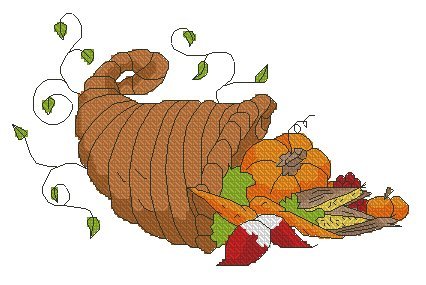Is Polyester Stretchy?
All You Need To Know About Polyester
Picking the right materials for your products is one of many important decisions that highly impact your eCommerce business. Your fabric choice can affect how vibrant your designs look on products, how comfortable they are to wear, and how good they hold up in the long term.
Polyester is one of the most popular fabrics in the world and has been a top pick by consumers since the day it was created. Its properties like durability, resistance to moisture, light weight, and versatility make it a fan favorite among both designers and buyers worldwide. The polyester industry is estimated to continue growing and reach around $160 billion by 2027.
In this article, you’ll learn everything you need to know about polyester and get answers to common questions like:
- How is polyester made?
- When did we create polyester?
- Is polyester stretchy?
- Is it better to print on polyester or natural fabrics?
- Does polyester stretch out after washing?
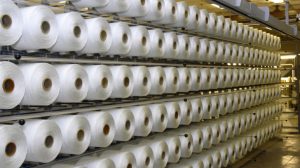
What Is Polyester?
While Chemistry 101 states polyester is a category for polymers, generally, the term is used to describe a synthetic material made from polyethylene terephthalate (PET) fibers. Yes, that’s the same material most plastic water bottles are made from.
It was created in 1929 (we’ll get back to that later) but skyrocketed in popularity in the 70s. Designers and manufacturers fell in love with it because of its cost-effectiveness, durability, and versatility.
Today, polyester is mainly used to make clothing fabrics for anything from outerwear to activewear to comfy hoodies. The list doesn’t end there, though, because of polyester’s durability. It’s excellent for making household and even industrial products like ropes, air filters, and liquid crystal displays (LCDs).
How Is Polyester Made?
Today’s technology allows us to make polyester in two main ways — entirely from scratch or by recycling used plastic. Both methods create a durable, wrinkle-resistant, and versatile material that can be used to make products from t-shirts to pet bandanas. Let’s take a closer look at each method.
Polyester Made From Raw Materials
If you enjoyed your school spelling bee, you’re going to love pronouncing the following chemistry terms.
When making polyester from scratch, the main ingredient is ethylene glycol derived from petroleum. To achieve a monomer, manufacturers continue by reacting ethylene glycol with dimethyl terephthalate (DMT) to create a monomer that’ll react one more time with DMT to produce a polymer.
Next, the polymer is melted and goes through an extrusion process. It forms long strings, which are later broken down into tiny PET pellets. This is the same material plastic water bottles are made from.
The small pellets are melted and pushed through something like an oversized sieve to create large threads. Once they cool down, they’re twisted together, and voila—you now have polyester yarn.
Polyester Made From Recycled Plastic
By recycling plastic, you not only reduce the amount of plastic waste in landfills but also provide a more sustainable alternative for polyester production.
The latter stages of the process used to make polyester from recycled plastic are similar to those mentioned above, yet the material’s origin is quite different.
Let’s take plastic bottles, for example. First, they are shredded to make sure no liquids are left inside. Then the pieces are sorted into clear and dyed plastic, followed by special baths where the caps and stickers are removed. The remaining shreds are then dried, and the process continues with melting and extrusions, just like in the previous method.
History of Polyester
The roots of polyester can be found back in 1929 when Wallace H. Carothers, the American scientist who invented nylon, first discovered that carboxylic acids could be mixed with alcohols to create synthetic fibers.
For a hot second, people’s fascination with nylon took the spotlight from polyester. Things changed in 1941 when PET was patented. Soon after this breakthrough, the first polyester fibers came to life.
People were amazed by its strength and how it holds up against regular wear and wash—you could own clothing that would last you a long time and show no signs of wrinkles and damage.
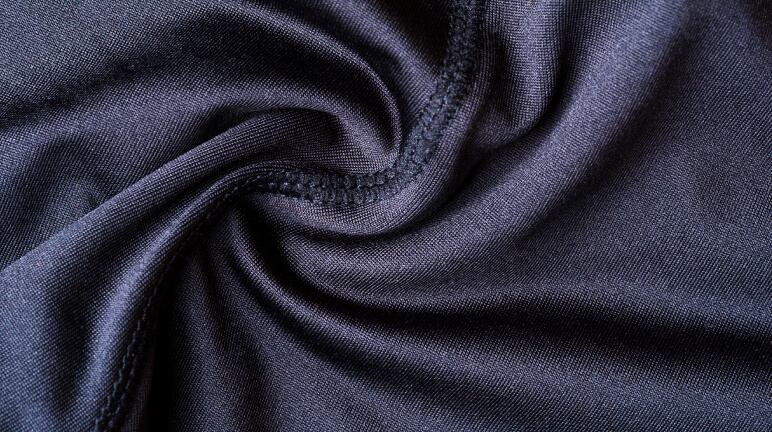
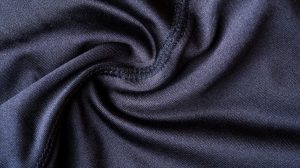
So Is Polyester Fabric Stretchy?
Polyester fibers don’t have any elasticity by default, so 100% polyester fabrics are not stretchy. In fact, they were made to retain their shape and withstand rougher wear and tear. They may give in if the cloth is wet but not quite enough to see any real difference. There are two ways you can achieve some movement and stretch with pure polyester:
- Knitting the fibers gives it stretch along the width of the fabric.
- Crimping the fibers creates elasticity.
Mainly though, when people talk about stretchy polyester, they refer to a polyester blend, aka poly blend, where polyester is combined with a different type of fiber to achieve specific characteristics. In most cases, spandex (also known as lycra or elastane) is added to create a stretchy fabric.
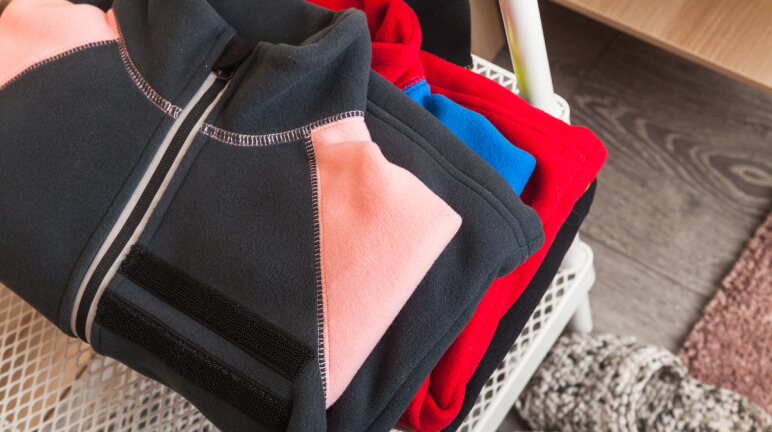
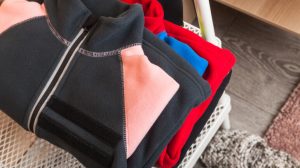
Different Types of Polyester Blends
Not all poly-blends are created equal. Each one has a specific purpose to fulfill. Some are made to be durable and water-resistant. Others need to be stretchy to move comfortably with the body. Polyester can be mixed with both natural and synthetic materials to manufacture fabrics with different characteristics.
Let’s take a closer look at the three most common types of poly-blends.
Poly-cotton Blends
When polyester is blended with cotton, the most widely used material among natural fibers, they create a fabric that combines the best of both worlds. Cotton brings breathability, while the polyester makes sure the fabric will stay intact for a long time.
The garment is soft to the touch and resistant to wrinkles. However, this type of polyester clothing is not stretchy. Even if it’s a knitted polyester fabric, it will only give in a tiny bit.
If you want your products to feature synthetic and natural materials, we suggest going for a poly-cotton blend. The prints come out much more vibrant and colorful when cotton fibers are present, compared to fabrics solely made from polyester fibers.
Check out these poly-cotton Printify products:
Polyester and Spandex Blends
Most designers will confirm that this polyester blend is the best choice for activewear. Spandex is stretchy and resilient (bounces back to its original form after stretching), so it helps the garment fit snuggly and move comfortably with the body. Polyester keeps us dry, thanks to its moisture-wicking properties. Altogether, it’s the perfect combo for cozy days at home or hardcore sessions at the gym.
A little goes a long way with spandex—you only need a tiny bit to make polyester stretchy. Even adding 10% of spandex can make the whole fabric stretch to almost double f its size.
Popular polyester-spandex blend products on Printify:
Tri-Blend
A Tri-Blend fabric is, you guessed it, made from three different fibers—cotton, polyester, and rayon. We’re already familiar with the first two, but rayon often silently slips under everyone’s radar. It’s a semi-synthetic fiber manufactured from both human-made and natural materials, like cellulose derived from wood and other plant fibers.
Rayon is lightweight, breathable, and moisture-absorbent, but it’s the exceptional softness and the way it drapes that creates the unique feel of Tri-Blend fabrics. Combined with the strength of polyester and the comfort of cotton, this fiber trio creates exceptionally comfortable garments.
Browse Printify Tri-Blend products like:
Does Polyester Stretch Out or Shrink After Washing?
Polyester fibers were made to be incredibly durable—regular washing, even in warm water, doesn’t harm 100% polyester fabrics. Remember, it’s essentially plastic, so as long as you keep it away from very high temperatures, it’ll survive practically anything. Think of it like the Ring of Power that could only be destroyed by lava.
However, polyester blends can lose shape over time if not taken care of properly. All clothing items on Printify have detailed care instructions in the product descriptions, so you can make sure they spark joy in your customers’ lives for many years to come.
Printing on Polyester vs. Natural Fibers
The fabric you choose as the canvas for your designs really impacts the print quality—how vibrant the colors are and how the artwork holds up after washing and regular wear. Synthetic and natural fibers absorb dyes differently.
Let’s consider direct-to-garment (DTG) printing, one of the top decorating methods in Print On Demand, most often used to bring colorful and detailed designs to life. These printers use water-based inks, and if we look at the properties of 100% polyester, one of them is water-resistant.
This doesn’t mean that the artwork won’t stick to clothes with polyester fibers. The fabric just needs to be pretreated with a particular solution to fill in the tiny gaps and create a smooth surface for printing. It’s best to choose light-colored polyester garments for DTG printing to make the design as vibrant as possible.
On the other hand, we have natural fibers that are primarily water-absorbent by default. Cotton is the number one choice for printing with water-based inks as it fully absorbs them. Not all types of cotton are the same—it’s best to choose ones that are smooth, soft, and on the thicker side to ensure the design lasts longer.

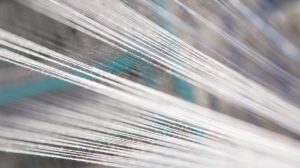
What Other Types of Plastic Fibers Are There?
Synthetic fabrics have changed the game when it comes to how easy it is to create durable, weatherproof, soft, and elastic fabrics. Another excellent quality is that they serve as an ethical alternative to animal-derived textiles, such as fur. Polyester is just one of many fantastic materials made from plastic.
Let’s look at these three popular synthetic fibers and their characteristics.
Nylon
Nylon is where it all began—it’s the first synthetic fiber that reached mass production. It’s one of the most versatile materials out there that people use to make products ranging from apparel to upholstery to seat belts.
This durable fiber makes up a very elastic fabric, is resistant to wrinkles, and shows remarkable resilience. You can find high-quality blank products that are made from nylon in the Printify catalog, like:
Acrylic
Acrylic is everyone’s best friend when the cold weather hits because of its ability to retain heat. It’s moisture-resistant, easy to clean, soft, dries fast, and has a wool-like feel. It’s often used to make fall and winter accessories like hats, gloves, scarves, as well as clothing—hoodies, sweaters, coats—all that cozy stuff. Because of its texture and soft feel, it’s also seen as a cheaper substitute for cashmere.
As far as stretchiness goes, acrylic and polyester are essentially in the same boat. Both are plastic and don’t have any elasticity by default. Acrylic is often knitted, so this particular layout will give in a little bit compared to woven fabrics.
Design and sell your own acrylic accessories with Printify:
Spandex
Spandex dates back to the 50s when it was discovered by an American textile chemist Joseph C. Shivers. Apart from being very elastic (it can stretch more than five times its original size) and resilient, spandex is very lightweight, tear-resistant, and doesn’t pill. One of the reasons it’s so popular among hosiery manufacturers is that it doesn’t create a very annoying static cling.
Spandex is most widely used in making apparel that needs to be tight-fitting and comfortable, like activewear, swimwear, compression clothing, and pants. The Printify catalog features various blank items that are made with spandex, such as:
FAQ
How is polyester fabric stretchy if it’s made from plastic?
Polyester fibers have absolutely no elasticity whatsoever. The only ways to stretch polyester are by crimping it, knitting it in a unique layout, or combining it with elastic fibers to create a blended fabric.
Polyester-spandex blend is the most popular combo for creating comfortable, soft, and super stretchy clothing. Adding even as little as 10% spandex to the garment can make it stretch to double its original size in any direction.
Are all polyester blends stretchy?
No. Each polyester blend is created to serve a specific purpose. Some are made to be elastic. Some are made to be durable, some — waterproof. For example, polyester-cotton blends are very popular among designers, manufacturers, and customers, yet polyester and cotton fibers have no natural elasticity. They’re soft, smooth, breathable, and strong but not stretchy.
The same goes for polyester-nylon blends. This combo is the standard for making seat belts for vehicles. We need strength and rigidity in these cases rather than stretch and resilience.
Is polyester flammable?
Polyester fibers are not highly-flammable—they take a while to ignite and require more heat than most fabrics. It does, however, start rapidly melting and dripping at high temperatures, just like plastic. Polyester ignites at 809.6°-910.4°F (432°-488°C) and melts at around 428°F (220°C).
Remember that polyester is often blended with other types of fibers, which can affect how quickly the fabric catches fire and how it burns. Be careful if you encounter burning polyester—the fumes it creates are toxic to humans and animals.
Does polyester clothing lose its shape after a while?
100% polyester clothes tend to last a lifetime if properly cared for. Clothing manufacturers specifically use polyester to ensure that the garments stick to their original form after being washed. Another excellent quality of this material is that it doesn’t quickly fade in the sun.
These fibers are incredibly durable, though they have one nemesis—high heat. Remember, polyester is made from plastic, and when plastic comes into contact with high heat, it can deform through melting or shrinking.
Ensure you include care instructions for all your products containing polyester material and remind buyers not to iron, tumble dry, or wash them in hot temperatures.
What can you make with polyester fibers?
Being one of the most versatile materials, polyester is most often used to make fabrics for clothing, especially activewear, but the list doesn’t end there. Other uses include basically anything you can think of—towels, face masks, blankets and bedding, industrial ropes, seat belts, tote bags—the list can go on forever.
Is polyester breathable?
It can be if it’s manufactured for that purpose. Polyester fabrics are made from solid plastic fibers, and plastic doesn’t let the air go through it, so we can only achieve breathability with specifically knitted polyester.
Another characteristic that goes along with fabric breathability is the ability to repel water. What’s great about polyester is that it doesn’t absorb moisture. If any water droplets are present, they move around the fabric, eventually traveling to the outside, where they evaporate. This is why polyester is so widely popular among activewear clothing brands. No one wants to walk around the gym sweaty.
How to take care of polyester fabrics?
Each polyester clothing item requires different care because it can feature various ratios of blended fibers. The general guideline for washing 100% polyester is to do it in cold water (<90°F or 30°C) with a detergent and fabric softener specifically made for synthetic fabrics.
Manufacturers recommend soaking the dirty areas in a mixture of laundry detergent and water if the fabric is heavily stained. More attention should be paid to garment areas covering the armpits, neckline, and wrists.
We highly recommend against ironing and tumble drying clothes that contain polyester on high heat. To fast-track the drying process, these items can be put in the dryer, but not for long periods of time so as to avoid deformation.
Polyester is wrinkle-resistant by default, but if some minor tweaks need to be made, it’s better to use steam instead of a clothes iron.
Parting Words
All polyester fabrics are not created equally — some are very stretchy, and others will stay rigid through thick and thin. Some are breathable and perfect for hot summer days. Others will keep you dry and protect you, come rain or snow. It all depends on how the fabric is made.
We hope that now you understand what manufacturing processes can create some stretch in 100% polyester and how blending it with other synthetic materials boosts the fabric’s elasticity.
In summary, polyester is an excellent, durable, and versatile fabric you can use as a canvas for your designs. We have lots of blank products that feature polyester in the Printify catalog, so put your creative hat on and make some poly masterpieces that’ll bring joy to your customers’ lives for many years.
Make It Happen Today!
The post Is Polyester Stretchy? All You Need To Know About Polyester appeared first on Printify.







